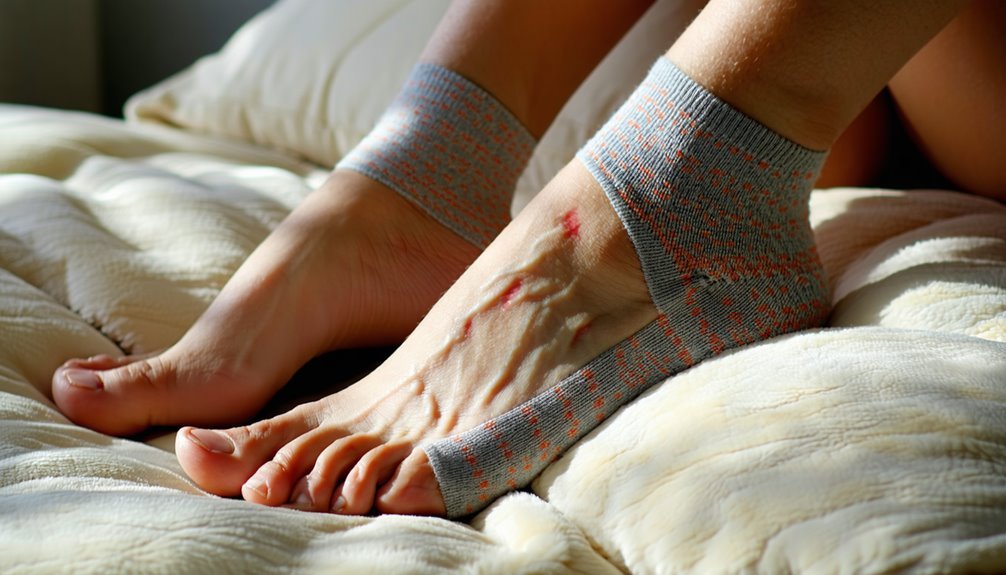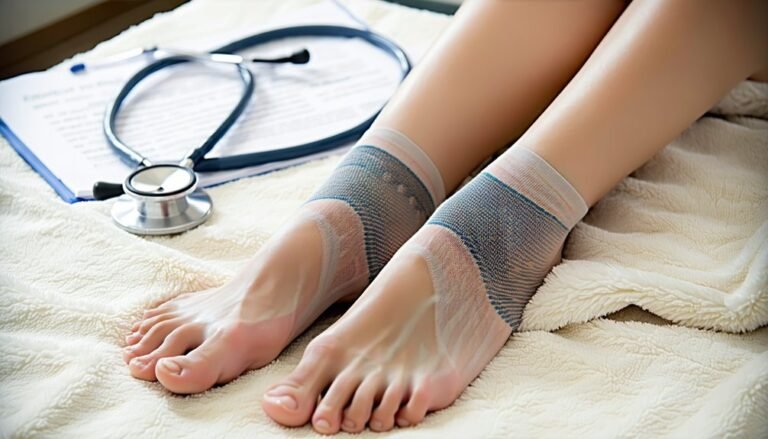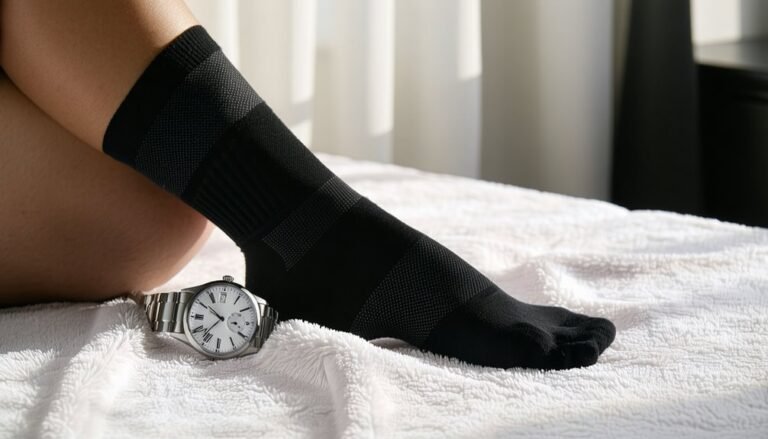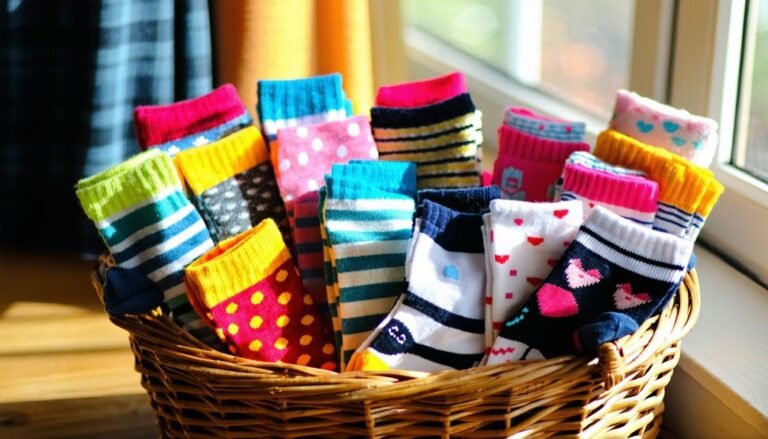Can Tight Socks Cause Swelling?
Wearing tight socks can impede circulation, potentially causing swelling in the legs, known as edema. Excessive pressure from constriction can also lead to nerve discomfort, presenting as numbness or tingling sensations. Consider breathable materials and proper size to avoid these issues. Maintaining an ideal fit is essential to prevent complications such as venous stasis. For further insights into protecting your circulatory health, there's more valuable information available.
Understanding Blood Flow and Lymphatic Drainage

Understanding how blood flows and lymphatic drainage functions in the body is crucial for recognizing the impact of external factors like tight socks. Blood circulation is essential for delivering oxygen and nutrients to tissues while removing waste products. Your vascular system, consisting of arteries, veins, and capillaries, facilitates this circulation. The lymphatic system complements this by maintaining fluid balance and playing a critical role in immune defense. Lymphatic health guarantees that excess fluid and toxins are efficiently removed from tissues, preventing swelling and congestion. When external pressure, such as tight socks, disrupts these systems, it can impede blood flow and lymphatic drainage. This may lead to discomfort or swelling, highlighting the importance of wearing properly fitting apparel to maintain effective circulatory and lymphatic function.
The Impact of Compression on Circulation
Although compression garments are widely used for their therapeutic benefits, it's important to recognize how they affect circulation. Compression socks apply graded pressure to your lower extremities, promoting circulation improvement by assisting venous blood return to the heart. This process helps reduce venous stasis and prevents conditions like deep vein thrombosis. However, if worn incorrectly, compression socks can negatively impact circulation, leading to potential complications. Ensuring the right fit is essential; overly tight compression socks may obstruct blood flow and increase the risk of swelling, rather than alleviating it. It's important to consult with a healthcare professional to determine the appropriate level of compression and proper wear. Prioritize your safety by regularly monitoring for any signs of discomfort or changes in circulation.
Recognizing Symptoms of Swelling
You may notice swelling in your legs as a result of tight socks, which can impede proper circulation and lead to fluid retention. Pay attention to signs like skin indentations from sock elastic, persistent puffiness, or a feeling of heaviness. It's essential to differentiate these symptoms from other causes like venous insufficiency or lymphatic issues to address the underlying problem effectively.
Identifying Swelling Causes
When evaluating the potential causes of swelling, it's important to recognize the specific symptoms that accompany this condition. Swelling, or edema, can manifest in various forms, each with different underlying potential triggers. Understanding these is vital for ensuring your safety and well-being. Here are some common swelling types and potential triggers:
| Swelling Type | Potential Triggers |
|---|---|
| Peripheral Edema | Prolonged sitting or standing |
| Lymphedema | Lymphatic obstruction |
| Pulmonary Edema | Heart conditions |
| Cerebral Edema | Traumatic brain injury |
| Angioedema | Allergic reactions |
Recognizing these symptoms early can guide you in seeking timely medical attention. Pay attention to any unusual puffiness, tightness, or discomfort. Identifying the root cause is essential in preventing further complications and ensuring effective treatment. Stay informed to protect your health.
Signs of Leg Swelling
Leg swelling can often be an indicator of underlying health issues, and recognizing its symptoms is essential for timely intervention. You should monitor for swelling indicators such as increased leg circumference, taut or shiny skin, and persistent leg discomfort. Edema, characterized by fluid accumulation, may present as a noticeable puffiness, particularly around the ankles and calves. It's vital to assess whether the swelling is bilateral or localized, as this can guide diagnosis.
Pay attention to your skin's texture; if it feels tight or leaves an indentation when pressed (pitting edema), it's a sign of fluid retention. Additionally, if you experience pain, warmth, or redness along with swelling, these could signify more serious conditions like deep vein thrombosis. Prioritize your safety by consulting healthcare professionals for persistent symptoms.
Common Reasons for Wearing Tight Socks
Although the allure of tight socks may not be immediately obvious, there are several practical reasons individuals opt for them. From a clinical perspective, tight socks can enhance circulation by providing gentle compression, a benefit particularly valuable for athletes. If you're engaging in sports, these socks might support your athletic preferences by reducing muscle fatigue and enhancing performance. They can also align with recent fashion trends, offering a sleek appearance under tailored clothing, which some find appealing.
However, it's essential to guarantee you select the appropriate fit. Socks that are too constrictive can impede blood flow, potentially causing discomfort or swelling. Always consult with a healthcare professional if you're uncertain about the suitability of tight socks for your specific circulatory health needs. Safety should always come first.
Evaluating Sock Material and Design
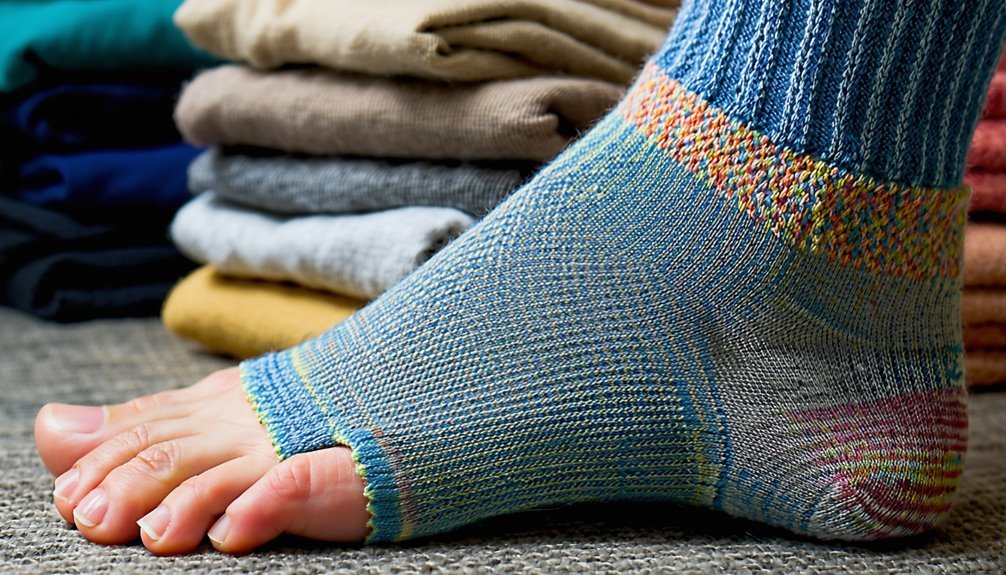
Selecting the right sock material and design plays a significant role in guaranteeing both comfort and health, especially when tight socks are part of your wardrobe. You should prioritize sock breathability to prevent moisture accumulation, which can lead to skin irritation or fungal infections. Opt for materials like cotton or merino wool, known for their moisture-wicking properties. Material elasticity is equally important; it guarantees the sock conforms to your foot without excessive constriction, reducing the risk of circulatory issues. Look for socks with a blend of elastic fibers like spandex or Lycra, offering both support and flexibility. Proper design also includes seamless construction to minimize friction and pressure points. By focusing on these factors, you promote ideal foot health and comfort.
How Tight Is Too Tight? Signs to Watch for
When evaluating whether your socks are too tight, it's essential to monitor for red marks on your skin, which indicate excessive pressure. You should also be alert to skin indentations, as these suggest restricted circulation. Experiencing numbness or tingling in your feet can be a warning sign of compromised blood flow, necessitating an immediate adjustment in sock fit.
Identifying Red Marks
How can you tell if your socks are too tight? Begin with red mark identification. When you remove your socks and notice pronounced red marks on your skin, it's a significant indicator. These marks suggest that your socks may be constricting blood flow, leading to potential swelling or even discomfort. Engaging in sock fit analysis can help. Assess whether your socks are leaving marks after short periods of wear. Consider the elasticity of the fabric and whether it accommodates your foot and leg without excessive pressure. If red marks persist, it may be time to adjust your sock size or style. Prioritizing a proper fit guarantees comfort and promotes healthy circulation, reducing the risk of complications from overly tight socks.
Noticing Skin Indentations
Noticing red marks is the first step, but skin indentations offer another significant clue regarding sock tightness. When socks are too tight, they can lead to prolonged compression, causing skin irritation and possible circulation issues. Identifying these indentations is essential for ensuring ideal foot health.
Here are signs to be vigilant about:
- Persistent Indentations: If marks remain for extended periods after removing socks, consider loosening them to promote healthier blood flow.
- Tenderness or Discomfort: Indentations that cause pain can indicate excessive pressure, potentially leading to skin irritation.
- Swelling: If your lower extremities appear swollen, it might be due to impaired circulation from overly tight socks.
Monitoring these signs can guide you in selecting the right sock fit, thereby preventing long-term complications.
Experiencing Numbness or Tingling
Ever wondered if socks could be too tight for comfort? Experiencing numbness or tingling sensations might be a clear indication. Your socks could be exerting excessive pressure on the nerves, leading to these symptoms. Numbness causes concern because it indicates disrupted nerve signaling, potentially due to restricted blood flow. When socks are too tight, they can compress the peripheral nerves, especially around the ankles, resulting in tingling sensations or a pins-and-needles feeling.
To guarantee safety, monitor for any persistent numbness or tingling that doesn't subside after removing the socks. If these symptoms persist, it's vital to consult a healthcare professional. Select socks with adequate elasticity and proper fit to prevent nerve compression and maintain ideal circulation. Your comfort and health matter.
The Role of Socks in Athletic Performance
While often overlooked, the role of socks in athletic performance is essential for optimizing both comfort and efficiency. Selecting the right socks can greatly enhance your experience and minimize injury risks. Sock performance directly influences your foot's support, moisture control, and temperature regulation.
The importance of socks in athletics is crucial for maximizing comfort, efficiency, and reducing injury risks.
- Support: Properly fitted socks can prevent blisters and reduce the likelihood of ankle sprains by providing stable support.
- Moisture Control: High-performance materials wick away sweat, reducing fungal infections and maintaining skin integrity.
- Temperature Regulation: Advanced fabrics keep feet cool in heat and warm in cold, enhancing endurance.
When prioritizing athletic benefits, consider sock fibers, compression levels, and fit. These factors contribute to improved circulation and protection, ensuring you stay safe and perform at your best during physical activities.
Health Risks Associated With Prolonged Use
When worn for extended periods, tight socks can lead to several health risks due to compromised circulation and tissue compression. Sock pressure can restrict blood flow, causing circulation issues that might result in swelling, discomfort, or even more severe conditions like deep vein thrombosis (DVT). It's essential to be aware of these risks and monitor any symptoms.
| Symptom | Possible Complication |
|---|---|
| Swelling | Edema |
| Numbness | Nerve damage |
| Discoloration | Circulation obstruction |
Persistent sock pressure can exacerbate these problems, so it's important to guarantee you're wearing appropriately fitting hosiery. If you experience any of the symptoms listed, seek medical advice promptly. Remember, your safety and well-being should always come first, and being proactive can prevent serious complications. Proper care and attention can alleviate risks associated with prolonged use.
Tips for Choosing the Right Hosiery
Understanding the potential health risks of tight socks underscores the importance of selecting the right hosiery for your needs. To guarantee your comfort and safety, consider these clinical guidelines:
- Sock Fit: Choose socks that offer a snug fit without constricting your circulation. Avoid overly tight bands that can impede blood flow.
- Hosiery Materials: Opt for materials that provide breathability and moisture-wicking properties, such as cotton or bamboo. This reduces the risk of skin irritation and maintains peak skin health.
- Compression Levels: If you require compression hosiery, consult with a healthcare professional to select the appropriate level for your condition. Proper guidance guarantees therapeutic efficacy while preventing adverse effects.
Prioritizing these factors can mitigate the risk of swelling and enhance overall foot health.
Alternatives to Traditional Tight Socks
For individuals seeking alternatives to traditional tight socks, considering options that prioritize comfort and circulation is essential. Opt for compression alternatives such as graduated compression socks, which exert less pressure at the cuff, facilitating lymphatic flow. These socks can support vascular health by improving venous return while minimizing edema risk. Additionally, explore socks crafted from breathable materials like bamboo or merino wool. These natural fibers regulate temperature and wick moisture, reducing skin irritation and potential swelling. When selecting these alternatives, make certain they're appropriately sized to avoid constriction. Prioritize socks with a seamless design to prevent skin abrasions and enhance comfort. By making informed choices, you'll support your circulatory system and promote overall lower limb health without compromising safety.
Frequently Asked Questions
Can Tight Socks Cause Permanent Damage to Feet?
You're concerned about tight socks causing permanent damage. They can lead to circulation issues, impacting foot comfort. Persistent constriction might cause long-term harm. It's crucial to choose socks that promote healthy circulation to guarantee your feet's ongoing well-being.
Are There Specific Brands Recommended for Sensitive Feet?
Worried about comfort and safety for sensitive feet? Why not explore brands using sensitive materials and compression alternatives? They offer therapeutic benefits, reducing discomfort, and ensuring you're prioritizing foot health without compromising on everyday support.
Do Tight Socks Affect Foot Temperature Regulation?
Tight socks can impede foot temperature regulation by restricting blood flow, potentially leading to circulation issues. It's vital to choose appropriately fitting socks to maintain ideal blood circulation and guarantee your feet remain warm and healthy.
Can Tight Socks Contribute to Varicose Veins?
Imagine a traffic jam in your veins. Tight socks can squeeze your legs, hindering blood circulation, potentially contributing to varicose veins. Ensuring proper fit and compression level is essential for maintaining vascular health and preventing complications.
Should Pregnant Women Avoid Tight Socks?
As a pregnant woman, optimizing sock comfort is essential. Tight socks can impede blood circulation, increasing risks of swelling and discomfort. Prioritize looser, supportive hosiery to maintain vascular health and guarantee maternal and fetal well-being.

